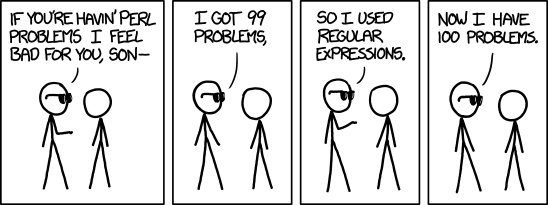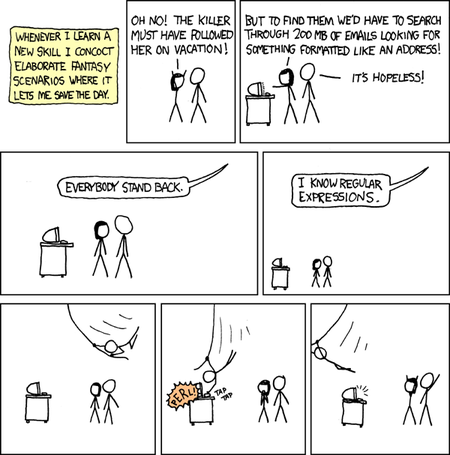Regular Expressions
A ‘language’ to represent text patterns - concept invented in the 1950’s
Bound by a set of rules (syntax); a set of special characters used to denote patterns
Multi-platform: available (natively or through libraries) in many languages and tools (R, Python, Java, sed, awk)
Use cases:
- read files with a specific naming pattern, e.g. 20190114_Mon_P1_W08_R2.csv, 20190114_Mon_P10_W01_R3.csv
- search for text patterns
- replace text patterns
The basics
Character classes
[]- any character:
. - alphabet:
[A-Z]or[:upper:],[a-z]or[:lower:],[A-Za-z]or[:alpha:] - numeric:
[0-9]or[:digit:]or\d - alphanumeric:
[A-Za-z0-9]or[:alnum:] - whitespace (space, tab, linebreak):
\s
- any character:
quantifiers:
- one or more (of the preceding character):
+ - zero or more:
* - zero or one:
? - specified number:
{m,},{m,n}
- one or more (of the preceding character):
The basics
anchors:
- start:
^(except in the context of[^ ], where it is negation) - end:
$
- start:
capture groups:
- extract groups:
() - refer to captured groups:
\1,\2, etc.
- extract groups:
metacharacters:
. \ | ( ) [ { ^ $ * + ? ,
Examples
in the string “the cat in the hat has a bat”:
[ch]atmatchescatandhat.atmatchescat,hatandbat.{2}matchesin[:alpha:]{1,2}matchesinanda.\s.matchese c,t i,n t,e h,t h,s a,a b
Strings in R
- Strings (“character” class) are represented in R using " or ’
- But what about special characters like newlines and tabs? They are
represented as escape sequences.
printprints the escape sequence, whereascatprocesses them.
string = "First\tline\nSecond\tline"
print(string)
## [1] "First\tline\nSecond\tline"
cat(string)
## First line
## Second line
Strings in R
- What if the string contains an invalid escape character?
regex_string = ".\s."
## Error: '\s' is an unrecognized escape in character string starting "".\s"
- Regular expressions are represented as strings in R. But strings are processed first for escape characters. Unrecognised escape characters in strings throw an error, before even reaching the regex parser.
- Double backslahes needed for regex escape sequences
regex_string = ".\\s."
string = "the cat in the hat has a bat"
regexpr(regex_string, string)
[1] 3 attr(,“match.length”) [1] 3 attr(,“index.type”) [1] “chars” attr(,“useBytes”) [1] TRUE
Two problems Some people, when
confronted with a problem, think “I know, I’ll use regular expressions.” Now they have two problems. - Jamie Zawinski

Base R functions that use regex
grep()grepl()regexpr()gregexpr()sub()gsub()strsplit()list.files()
Stringr functions
As with other Tidyverse functions, Stringr functions take the text as the first argument and the pattern as the second argument
str_locate()- likeregexpr(), but returns an integer matrixstr_detect()- likegrepl()str_split()- likestrsplit()str_extract()- likematch = regexpr(pattern, string); substring(string, match, match + attr(match, "match.length") - 1)
Test drive
library(babynames)
library(stringr)
library(dplyr)
library(ggplot2)
library(ggpubr)
babynames %>%
group_by(name, sex) %>%
summarise(n = sum(n)) -> sum_babynames
sum_babynames %>%
filter(str_detect(name, "a$")) %>%
group_by(sex) %>%
count() %>%
ggplot(aes(x = sex, y = n, fill = sex)) +
geom_col(colour = "black") +
labs(title = "Names ending with 'a'") +
theme_pubr(border = TRUE)
babynames %>%
filter(str_detect(name, "a$")) %>%
group_by(sex, year) %>%
count() %>%
ggplot(aes(x = year, y = n, colour = sex)) +
geom_line() +
labs(title = "Names ending with 'a'") +
theme_pubr(border = TRUE)
sum_babynames %>%
filter(str_detect(name, "[aeiou]$")) %>%
group_by(sex) %>%
count() %>%
ggplot(aes(x = sex, y = n, fill = sex)) +
geom_col(colour = "black") +
labs(title = "Names ending with vowel") +
theme_pubr(border = TRUE)
babynames %>%
filter(str_detect(name, "[eiou]$")) %>%
group_by(sex, year) %>%
count() %>%
ggplot(aes(x = year, y = n, colour = sex)) +
geom_line() +
labs(title = "Names ending with a vowel other than 'a'") +
theme_pubr(border = TRUE)
sum_babynames %>%
filter(str_detect(name, "(.{2})\\1")) %>%
group_by(sex) %>%
#filter(sex == "M") %>%
count() %>%
#print()
ggplot(aes(x = sex, y = n, fill = sex)) +
geom_col(colour = "black") +
labs(title = "Names with repetitive characters") +
theme_pubr(border = TRUE)
sum_babynames %>%
filter(str_detect(name, "[HhZz]ero")) %>%
group_by(sex) %>%
#filter(sex == "M") %>%
#count() %>%
print()
## # A tibble: 36 x 3
## # Groups: sex [2]
## name sex n
## <chr> <chr> <int>
## 1 Acheron M 56
## 2 Cherod M 6
## 3 Cherokee F 2414
## 4 Cherokee M 337
## 5 Cherol F 17
## 6 Cherolyn F 60
## 7 Cheron F 635
## 8 Cheron M 99
## 9 Cheronda F 164
## 10 Cherone F 7
## # … with 26 more rows
babynames %>% group_by(year) %>% count() -> babynames_pop
left_join(babynames, babynames_pop, by = "year") -> babynames_complete
babynames_complete %>%
filter(str_detect(name, "^[^AEIOUaeiou]+$")) %>%
group_by(sex, year) %>%
summarise(n = sum(n.x/n.y)) %>%
#count() %>%
ggplot(aes(x = year, y = n, colour = sex)) +
geom_line() +
labs(title = "Names without any vowels") +
theme_pubr(border = TRUE)
babynames %>%
filter(str_detect(name, "^Joshua$")) %>%
group_by(sex, year) %>%
#count() %>% head()
ggplot(aes(x = year, y = n, colour = sex)) +
geom_line() +
labs(title = "") +
theme_pubr(border = TRUE)







